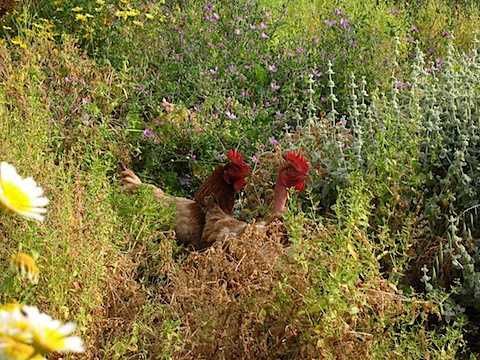- From guerrilla gardens to guerrilla flowerboxes.
- “Kuwait needs to have a national genetic bank for plants and seeds by using the help of international experts…”
- Restoration of Satoyama and wetlands by local citizens in Japan.
- Lots of variation in salt tolerance among Georgian wild wheats.
Depictions of sacred plants in Maya pottery investigated
Hot on the heels of the belated identification of the “penis pepper” depicted on Moche pottery comes more news of ethnobotanical detective work involving plant iconography. Natural historian and archaeologist Charles Zidar of the Missouri Botanical Garden and botanist Wayne Elisens of the University of Oklahoma looked at 2,500 images from southern lowland Maya (Belize, Guatemala and Mexico) ceramics dated to the Classical Period (AD 250 to 900). They focused on depictions of Bombacoideae, “which are easily identified morphologically and have culinary, medicinal, ceremonial, economic, and cosmological significance to the Maya.” Of the ten species present in the area, four or five were found represented on the ceramics.
“I was surprised that a variety of plants from this family were depicted,” says Zidar.
Among them is Ceiba pentandra:
Considered the “first tree”, or “world tree”, the ceiba was thought to stand at the centre of the Earth. Modern indigenous people still often leave the tree alone out of respect when harvesting forest wood.
The thorny trunks of the ceiba tree are represented by ceramic pots used as burial urns or incense holders, which are designed in a strikingly similar fashion.
Investigation of the plant images is continuing, and is being extended to animals. Here’s Zinder again:
By determining what plants were of importance to the ancient Maya, it is my hope that identified plants can be further studied for pharmaceutical, culinary, economic and ceremonial uses. More should be done to conserve large tracts of forest in order to properly study theses plants for their value to mankind.
LATER: By the way, there are some depictions of plants in Mayan art which have yet to be identified.
Location, location, location
Tracing Paper had a fun mosaic of food-themed maps yesterday. We’ve blogged about a couple of them before, and lots more actually, as it’s a bit of an obsession around these parts, but it’s fun to see them all together like that. And while we’re on the subject of geography, I got 8 out of 9 on the beer geography quiz that was also concidentally on Mental Floss this week. Can you beat that?
Nibbles: Phosphorus, Water lilies, Polish sheep cheese
- The looming P crisis. As is there’s not enough to worry about.
- Water pest makes itself useful in the Philippines.
- “To promote real Oscypek, Zakopane’s tourism bureau has created a special tour allowing visitors to find the mountain meadow huts of 25 baca cheesemakers.” Sign me up.
Semi-naked chicks go wild on Crete
“Eeyew. What’s wrong with that chicken?”
We were sitting on the shaded verandah of Nico, a lovely man who, after training as an architect in the US, chucked it all in to live off the grid and as sustainably as possible in a converted hovel in the west of Crete. No electricity, no running water, a wild garden and wilder chickens foraging through it.
Naturally I peered at the chicken, and there it was: naked-necked as I live and breathe.

“Golly, a naked-necked chicken, here on Crete.”
Nico, meanwhile, was answering my friend, and explaining that it was that way naturally and didn’t seem to be any different from the other chickens in his flock.
I waded in with information about the naked-necked chickens of Transylvania and elsewhere, citing the very latest thoughts on the subject, to-whit:
The use of single or combined dominant genes for feather restriction (Na) and feathering structure (F), as well as the sex-linked recessive gene for reduced body size (dw), has been found to be particularly relevant for the tropics (Horst, 1989; Haaren-Kiso et al., 1995). Research into the effects of these genes on economic factors has been undertaken in Malaysia (Khadijah, 1988; Mathur and Horst, 1989). For example, the feather restriction (Na) or Naked Neck gene results in 40 percent less feather coverage overall, with the lower neck appearing almost “nakedâ€. This considerably reduces the need for dietary nutrition to supply protein input for feather production, and protein is a limiting factor in many scavenger feed resource bases. Barua et al., (1998) has reviewed the available information on the performance of indigenous Naked Neck fowl in the hope that it will draw the attention of scientists worldwide to its interesting characteristics and facilitate future research.
I asked Nico whether the naked-necked birds were more efficient egg layers, or suffered less in the heat, but he didn’t know. I said I’d be happy to return to conduct a thorough investigation, but I haven’t had a reply yet.
The photo took some doing too, the birds treating me as an overlarge predator definitely up to no good. Which they should.